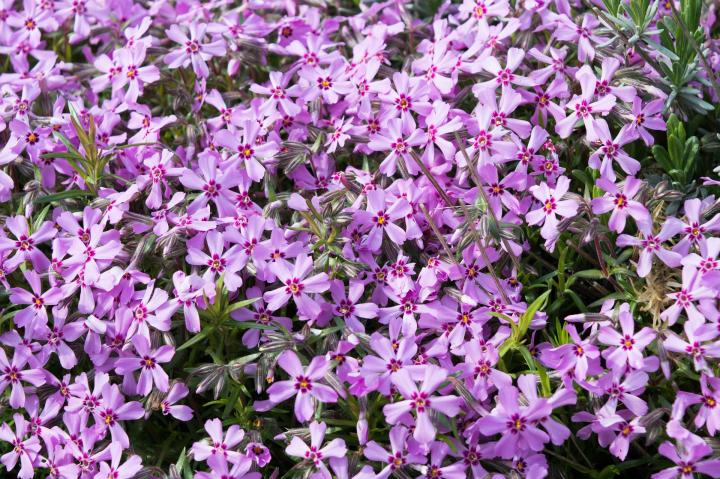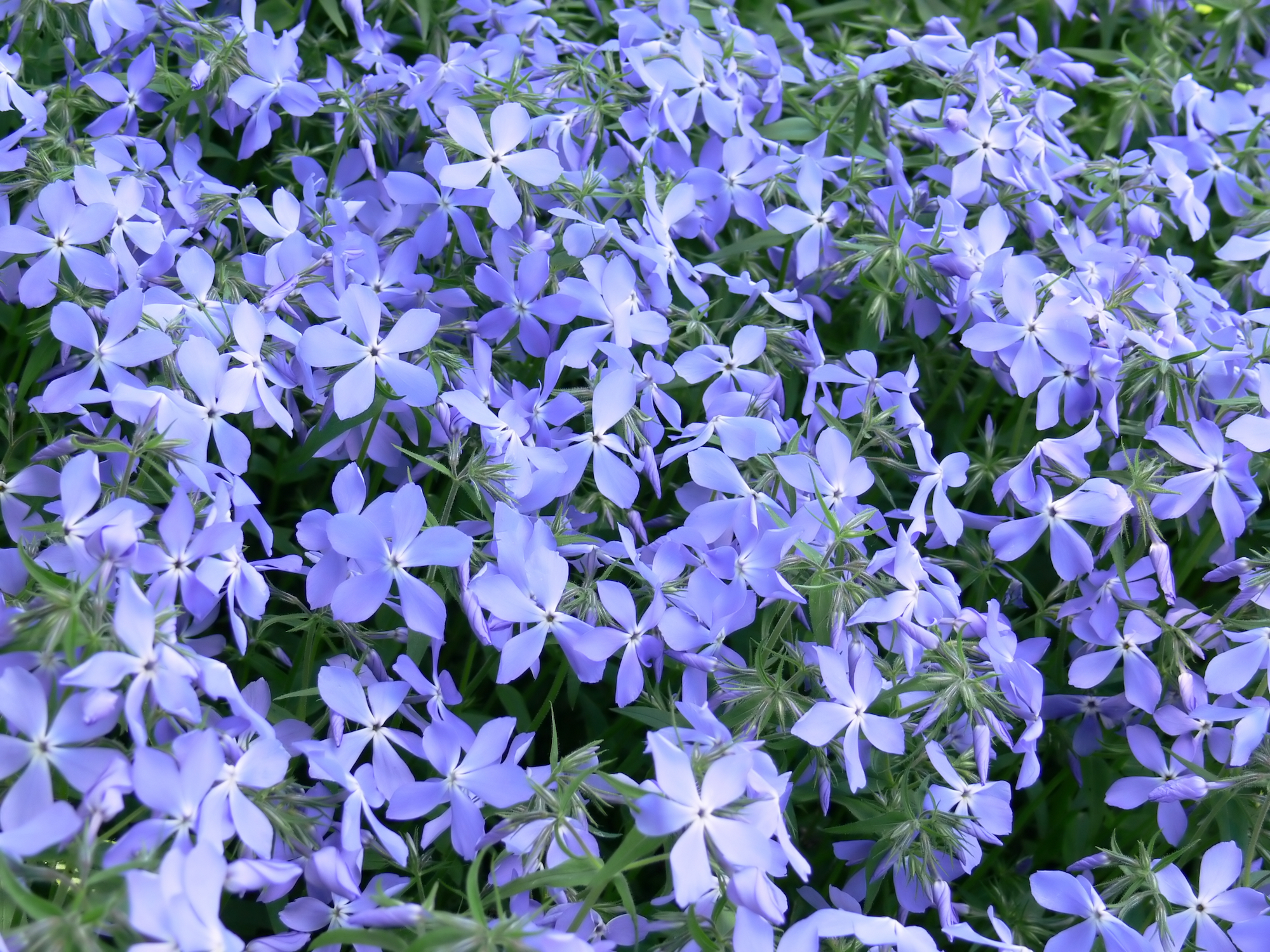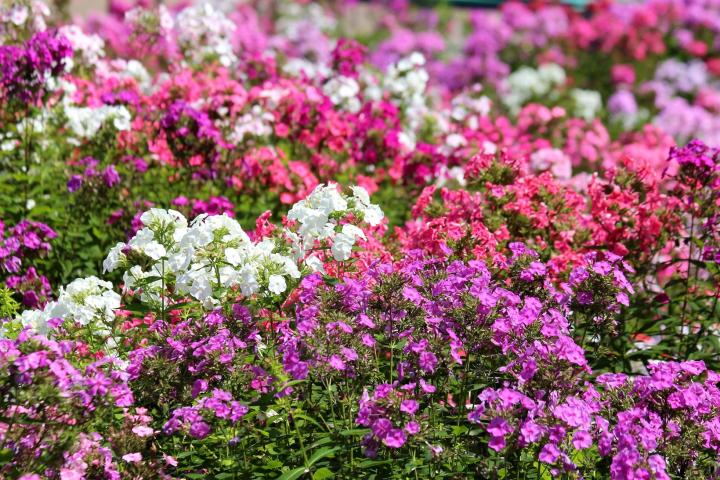
From Ground Covers to Garden Giants: Meet the Many Faces of Phlox
Read Next
Types
You just can’t go wrong with phlox! Here are some of the best species and varieties to try:
Low-Growing Phlox
- Creeping phlox or moss phlox (Phlox subulata) is a low-growing species that works excellently as a ground cover. It spreads slowly, growing in mounds that get 4–6 inches thick. The whole plant turns into a carpet of color in spring, when flowers cover every square inch of foliage. This phlox is particularly stunning when allowed to drape over a rock wall—imagine a waterfall of color! Creeping phlox grows best in well-draining soil and partial to full sun.
- ‘Candy Stripe’ is a popular variety with pink-and-white–striped flowers.
- ‘Emerald Blue’ produces a sea of lilac-blue flowers (perfect for that waterfall of color!).

- P. stolonifera, which also goes by the common names creeping phlox and moss phlox, is similar to P. subulata in name only. The main differences between it and P. subulata are that its leaves are oval-shaped (rather than needle-shaped), and its flowers are produced on stems that rise 6–10 inches above the foliage (rather than directly on the foliage). It prefers a shadier growing site with rich, evenly moist soil.
- ‘Sherwood Purple’ is a delicate little phlox with purplish-pink flowers.
- Woodland phlox or blue phlox (P. divaricata) is another low-growing species. As its two common names suggest, it prefers partial to full shade and moist, rich soils and produces bluish flowers in early spring. Like P. stolonifera, its flowers bloom on stems that rise about a foot or so above the creeping foliage.
- ‘Chattahoochee’ and ‘Blue Moon’ are two great varieties with beautiful blue-to-violet flowers.

Medium-Height Phlox
- Annual phlox or Drummond’s phlox (P. drummondii) grows as an annual rather than a perennial, unlike most other phlox species. Annual phlox rarely grows taller than 2 feet in height. Most varieties are not very heat tolerant, but in warmer regions, you may find the heat-tolerant varieties for sale. Plant in well-draining soil in a site that gets partial sun and doesn’t stay too wet.
Tall Phlox
- Garden phlox or summer phlox (P. paniculata) is the tallest phlox in cultivation and is probably the species that most folks have in their gardens. It grows in clumps that reach between 3 and 5 feet in height and produces panicles of flowers in mid- to late summer. Though tolerant of most lighting, it grows and flowers best in partial to full sun. It has a reputation for being very susceptible to powdery mildew, but resistant varieties are available.
- ‘David’ has bright white flowers and is resistant to powdery mildew.
- ‘Jeana’, another mildew-resistant variety, produces panicles of petite purplish flowers—similar in appearance to a butterfly bush.
Other Phlox
The phlox listed above are just a few of the many species out there. Others of interest to gardeners may be Carolina phlox (P. carolina), meadow phlox or spotted phlox (P. maculata), and sand phlox (P. bifida).
Gardening Products
Comments
Hi, Aubrey, This all sounds normal... It's fall: Phlox is a perennial, it will die back in autumn (as daylight lessens and cooler temps set in). Cut the plants back to about 3 inches (too much more might damage the crown). Remove debris from the bed to discourage diseases. When it's clear that the warm days are behind us, lay on a protective pillow of mulch. (Doing this too soon, while the soil is still relatively warm, might trigger regrowth.) Since this is the plants' first year, leave them intact, but in future consider that autumn is a good time to divide plants.
Hope this helps!
Do the leaves of your phlox appear to have a whitish dust on them? Phlox is quite hardy but also prone to powdery mildew if it's been humid or wet. It's fairly normal and doesn't usually hurt the plant. You can throw away the affected foliage and pinch off any other affected leaves; spray the rest of the plant with fungicidal soap.
If your phlox doesn't have powdery mildew, sometimes leave drop can happen with older phlox as the summer progresses. This is a signal that you may need to divide your phlox and and replant in compost-rich soil.
- « Previous
- 1
- 2
- …
- 10
- Next »










With phlox, you may pinch or cut back half way -- no later than early June. Note that legginess before bloom often comes from overfertilization, especially use of nitrogen, so avoid this.